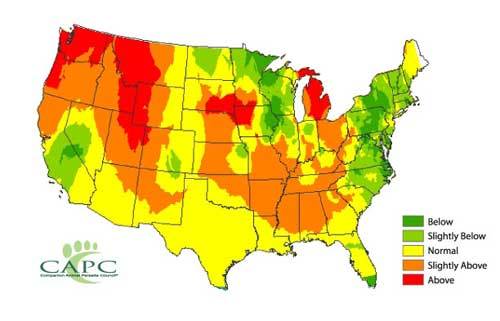Building the CAPC Forecast

As a mathematician, statistician and Clemson University professor, I have been studying time series and forecasting methods for over 20 years. I helped develop the mathematical models used to assess temperature and hurricane count changes in the United States and enjoy the challenge of analyzing various factors to identify commonalities and trends.
I was excited to learn that the CAPC collects and records millions of heartworm, Lyme and other pet parasite test results county-by-county across the United States, and updates them on a monthly basis. Such rich data sets provide a great opportunity to tap some of our seasonal time series methods, which had previously only been applied to climate forecasting. Given the collaborative potential, I eagerly joined the CAPC team of vector ecologists, entomologists, parasitologists and biologists.
I coordinate the efforts of Clemson experts – some of the country's leading statisticians – to complement the insights of CAPC parasitologists and build parasite forecasts. Our ever-evolving forecasts are based on logistic regression models that seek to explain the proportion of positive tests in relation to factors such as weather conditions, vegetation indices, wildlife population and human population density.
For each forecast, we identify the most important risk factors impacting the infection rates in the U.S. canine population of parasitic diseases, including Lyme disease, ehrlichiosis, anaplasmosis and heartworm. We use a spatial smoothing procedure based on the head-banging algorithm method described by Hansen to create a baseline map. The head-banging algorithm is particularly useful in describing data with high local variations, as it is median-polished (not easily influenced by outliers). This methodology is named after a child’s game where a face is pressed against a board of pins protruding at various lengths, leaving a general impression of the child’s face while smoothing away any excessively varying local features that are more attributable to random chance. We believe head-banging is more effective than classical Kriging smoothing techniques, since the latter could by unduly influenced by a few counties with high parasitic disease prevalence.
In developing parasite forecasts, we always consider human population data from the U.S. Census Bureau and land cover classified imagery with urban, rural and suburban land use classes as helpful model inputs to capture measures of urbanization. Geographic data are readily available from the U.S. Geologic Survey Land Cover Institute, the National Atlas of the United States and the U.S. Department of Agriculture Economic Research Service.
We also regularly examine meteorological data. In a forecasting model, weather (daily and monthly, and at various time lags) is expected to influence intra-annual fluctuations. In a static spatial model, climate – rather than weather – may better govern the likelihood a vector can complete its life cycle. In order to incorporate these influences, we include temperature (minimum, maximum, mean and daily variability) and moisture index (calculated based on precipitation and evaporation rates).
The CAPC-Clemson team relies on statistical principles, past experience and related data to forecast which parts of the country will have parasite population flares or increasing parasitic disease incidence in the coming months. For example, accounting for recent temperature and precipitation patterns added to the reliability of the CAPC’s forecast of Lyme disease risk for the fall of 2012.
By regularly evaluating the factors included in our predictive model, we improve accuracy. We add, subtract, or more heavily weigh some factors in a given year, depending on changing conditions. As we collect more and more data, our forecasts will improve.
While a lot of complex math, data and a significant amount of analysis go into the CAPC Parasite Forecasts, the bottom line is simple: Parasites pose threats to both pets and people no matter the season, and it’s important to guard against them. The parasite experts at the CAPC say they are preventable with year-round, easy-to-administer medication.
I'm proud to be a part of the CAPC, an organization dedicated to helping pet owners and veterinarians keep their animals and families healthy. I look forward to the evolution and refinement of the parasite forecasts, as we continue to help educate people about parasite risks and provide reminders to follow veterinarians’ recommendations for parasite prevention measures.
